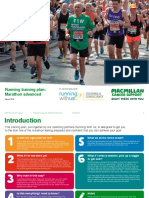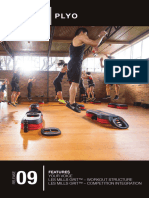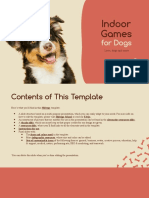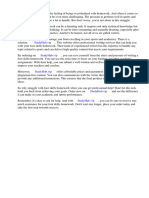Documento PDF 2
Documento PDF 2
Uploaded by
Juan-PabloChaperoArenasCopyright:
Available Formats
Documento PDF 2
Documento PDF 2
Uploaded by
Juan-PabloChaperoArenasCopyright
Available Formats
Share this document
Did you find this document useful?
Is this content inappropriate?
Copyright:
Available Formats
Documento PDF 2
Documento PDF 2
Uploaded by
Juan-PabloChaperoArenasCopyright:
Available Formats
Puppy Learn
! Training Agility
Pricing Blog Coaches Forum ( )
90
" Dashboard # My Profile $ My Dogs % Account Settings & Notifications
Different Ways To Train '
Training should always be fun. Every training session gives you more
experience and improves di!erent type of skills needed in game of agility
for the dog and handler.
Versatile exercises
I have been involved in agility for 21 years and still counting. Along the way many have asked
don’t I ever get bored to train or teach agility and repeat the same things over and over again.
Amazingly I feel I love agility more as time goes by. I think this is mostly because I learn and
understand more about agility and dogs which allows me to play around with various types of
excercises.
Both of us have been fortunate to teach and work with many of the top handlers in the world.
We have noticed one common feature for many of them which enables them to stay at the
top: the ability to be able to have fun and not get too serious and result
orientated when doing agility
agility. Atmosphere we have among us at OneMind Dogs enables
and supports us to find new ways to challenge each other, have fun with versatile excercises
and at the same time keep learning more and develop our own and our dogs´ skills further. We
hope to never loose our enthusiasm towards the sport and maintain positive attitude for next
decades to come.
Obstacle skills
Naturally most of the handlers start agility training by teaching individual obstacles for the
dog. It would be too easy if we would not have to maintain these skills every now and then
throughout the dogs´ career. Imagine yourself learning a new skill, for example a foreign
language, new dance or how to play an instrument. If you don´t practice your new skill for a
while, you don´t forget the skill entirely, but probably you don´t master the skill as fluently as
you if would have been enhancing and maintaining your skill frequently. We believe the
dogs also need the foundation obstacle training and proofing periodically
throughout their entire life.
Obstacle proofing can be done by making exercises which are more demanding you are
likely to ever face in competitions or by training the dog to be able to withstand various
distractions while performing obstacles. By a demanding “over training” exercise we mean for
example training sends to weaves from di!erent angles from the distance exceeding 75 feet
or making the send to certain obstacle surrounded by other obstacles from the distance of 45
feet. You can train distractions on all obstacles. Check out examples about distractions on
weaves and jumps. Weave your arms, shout or turn your body suddenly when your dog is on
the jump. Spin around or make a pushup while your dog is weaving. Run laterally away from
the contact obstacle or towards you dog when they are performing it. Only your imagination
is the limit when proofing your dog´s obstacle performance. Check out Next Level parts 1-10
for obstacle proofing tips.
Technique training
When you have learnt all the di!erent handling techniques there is no need to train them
all the time to keep them in mind. Only if some technique seems not to work perfectly every
time there is need to proof and enhance the skills related to that particular technique.
One excellent way to check the skill leves related to one individual handling technique is to
execute the technique multiple times in a row. You may be able to execute a certain
technique once or twice, even if there still is room for improvement in your performance, but
third or fourth time might be too much. We keep five repetitions in a row as our threshold. For
example most can do one Pull Through with ease, but being able to execute five of them in a
row doesn´t succeed if there is even slightest problem in execution or understanding of the
handling cue. This is something everybody can try with all the di!erent techniques: five
Forced Front Crosses, five German Turns, five Reverse Wraps with blinds etc.
Challenge yourself to improve your performance and train in sections to achieve as many
repetitions in a row as you can, until you reach the five in a row mark. Then you know you
master the skill really well. Always remember to execute all the drills in both directions. For
most of us either side tends to be better than the other. Executing the drills both sides evens
out our or our dog´s possible di!erences in using the body.
Handling technique applications
When you feel comfortable executing various techniques it is time to start timing and
comparing di!erent solutions
solutions. When taking time it is no point to be comparing bad Front
Cross to good Rear Cross, so bringing in the clock in training session should happen only
when you master all the techniques so well you can execute them comparably to each other.
When applying di!erent techniques in practice we take from three to five obstacles sequence
which we do and time the same sequence executed with di!erent handling techniques. As a
result we get information if some ways or strategies of handling are better for the certain dog
and handler. It is good to repeat some timing exercises from time to time, because your dog
and you get better and progress over time and your co-operation is smoother which may alter
the time di!erences between di!erent handling techniques as both of you get more and
more comfortable executing them. Sometimes the handling choice or route which feels the
fastest may not actually be that, so it is always worth to time the exercise every now and
then.
Handling technique application training is a great way to get to know your own dog
inside out
out. Di!erent solutions are faster depending on the dog and handler and how they
are working together. Some dogs don´t turn as tight as others, which in some situations
makes slicing the jump more beneficial compared to wrapping it. Some dogs have tendency
to slow down considerably when handler faces them, making the German Turn more likely to
be a faster handling option for them compared to a Forced Front Cross. Some dogs react
strongly to handler´s rhythm change and slow down a lot before a jump when handler is
starting to execute a Whisky Cross. This will make Forced Front Cross or Twist better choice
for this type of dogs. See an example of the timing sequence, picture 1.
Picture 1.
This sequence were some years ago in
Finnish Team qualifications. Most of the
people didn’t choose the fastest way for
them to do the sequence. Time the
sequence with di!erent routes and
di!erent handling techniques and find out
what is the best solution for you and your
dog. Sometimes the clock can surprise
you!
See some examples from di!erent routes and possible handling techniques for
the sequence:
Pictures 2 - 4.
Di!erent options for the sequence in picture
1.
Course training
Sometimes you can get a pretty good idea of how long sequences or courses handlers are
training just based on watching their performance in competitions. If you are mostly training
shorter, 10 to 15 obstacle sequences in training you are likely to be able to do more or less the
same amount of obstacles successfully in competitions. If you can´t make a clear 20 obstacle
course with a first try in training session you are not likely to be able to do it clear in
competitions either. After a solid foundation training it is time to train the course workwork. It is
important to train running whole courses. When you start running longer sequences the dogs
tend to speed up, which has a huge impact to the handler´s timing of cues and maintaining
good handling position throughout the entire run.
Our threshold in course work is to be able to do in three consecutive training sessions
without faults on the first try. Once you achieve this we think you can go back to training
shorter sequences or increase training motivation by varying the contents of the training
sessions. In our experience training “overlong” courses is an excellent way to
improve handler concentration and overall course working skills skills. Many top
handlers in Finland train and can successfully neqotiate overlong, from 30 up to 40+
obstacles, training courses. This type of training makes normal competition courses of 20 to
22 obstacles feel relatively short and therefore also easier.
This type of training is mostly meant for developing handlers´ skills. It might not
suit all dogs. Everyone should always first evaluate is their dog motivated enough to do so
many obstacles in a row without losing motivation and speed.
Clear round training
When Janita for the first time in 2004, was determined to make it in Finnish FCI World Team,
she started to exercise her ability to stay fully focused and concentrated throughout the
entire run. She started to do clear round training
training. “I started out with courses consisting of
20 obstacles. If I made any kind of mistake, even if my dog just made a turn in wrong direction
I stopped, rewarded the dog and started the run from the beginning. At first I could not even
make the course clear during the entire training session before my dog was so tired I needed
to stop. In these cases I came back in a day or two and continued trying with the same setup.”
“After a while we were already really consistently making clear rounds with the first try, so I
decided to make it more challenging and try to make it clear two times in a row. Soon it got
boring to run the same course many times so to get some variation I started to add more
obstacles and soon we were making clear rounds in courses consisting of 30, 40 and
eventually even up to 55 obstacles. Even if my dog dropped a bar at jump number 33, I always
started over from the start. I feel this training method has had a huge impact in our clear
round percentage, which I have been able to get in competitions with four di!erent dogs up
to the 90%.
How well you know your dog
When the pair can consistently do clear rounds, it is time to check how well the handler
actually knows her dog in agility. This exercise is best to do first on jumping course in order to
eliminate the e!ect of the speed of contact obstacle performance and possible 2on2o!
releases. It is best to do the exercise on a relatively easy course consisting of a normal
amount of obstacles. After the course walking the handler runs the entire course with a
virtual dog and they are timed. The handler tries to do the course exactly as with her actual
dog. The timer is started from the handler’s command when she pictures her dog performing
the first obstacle and it is stopped when handler gives a verbal cue at the time her virtual dog
executes the last obstacle. Next the run with the actual dog is timed and the times
are compared to each other. Timing of the handling according our threshold is ok if the
time di!erence is less than a second.
Sometimes this exercise reveals the timing to be o! by several seconds. This can explain for
some handlers why they have hard time of making clear rounds. It is extremely hard to
make an executable handling plan for your actual dog if you can´t see your
virtual dog accurately and make a plan for him first. The handling plan includes
evaluating if you are going to make it in time to places you would like to be on an agility
course in relation to your dog and choosing the most suitable handling manoeuvres.
Handling strategy
You are learning how to plan the handling strategy just by actually doing it. There are di!erent
types of exercises for improving the skill. In Finland we do not have games at all, but we think
they are a good way to master the skill of planning and executing a good handling strategy.
One nice exercise is “Make it as fast as you can” –drill. Obstacles have been set up
beforehand and start obstacle is predetermined, all obstacles are bi-directional. Handler´s job
is to make a course plan where all the obstacles must be done at least once and the total
amount of obstacles is predetermined and should be around 20. If the original set up consist
of 15 obstacles, some of the obstacles have to be performed more than once. In Finland we
don´t normally train to do one obstacle twice in a row, neither back and forth nor twice from
the same direction, but in this exercise I think you could do that if it is skill you need.
Everybody should be able to stick with their original plan they write down in course map in
advance. The first try counts and it is timed. Fastest clear round wins the competition.
Mental training
Competing is another skill we can and should train. The more you compete the easier it
gets. One way of training competing is to try to get more pressure for handlers in training
sessions by for example setting a bet of some kind. Everybody attending the training session
can bet a small amount of money and best result in first try wins all. Use your imagination
when setting a bet: two handlers with worst results need to do ten push ups etc, whatever
your group is comfortable with. You can play several rounds and the point is to try to make
everybody try their best in every round and perform under little bit more pressure than in
normal training session.
Disregarding distractions
We are coaching all levels of handlers and dogs and our main goal is to help everybody to
make progress from their current level and reach their full potential. Anything can happen in
competitions and handlers and dogs might have to face unexpected situations. We try to
prepare them to be ready for everything
everything. We call this distraction training
training. When
handler is prepared and used to face unexpected incidents she can stay calm and not to get
too emotional and distracted when something unforeseen happens in competitions.
We use several di!erent scenarios as distractions, for example just stop the handler after few
obstacles and say that timing did not start, course was not ready yet for them or give some
other excuse for interruption. We can put one bar on the ground beforehand, turn the
entrance or exit of the tunnel to point in di!erent direction, stand like the judge or ringworker
in handler´s running line at contacts, stand in the dog´s line before the jump “setting the bar
up” when dog is entering the same jump, throw a squeaky toy around beside the ringside etc.
From this link you can find one of our students run from o"cial competitions. Both, the
handler Riina Koskelma and her malinois Saga, can perfectly stay focused and make a clear
round despite slight distraction on their way as trained to do.
Missing the walkthrough
Sometimes handlers may miss the walkthrough. You can prepare yourself also for this
scenario. Over the years we have missed quite many walkthroughs and needed to run the
course just by going through the course from the sidelines. Jaakko has done a clear round
and placed on top almost in every competition he has missed the coursewalk. This is because
he is extra careful in his handling when he does not know exactly where all the obstacles are
situated. We call this training “Run without the walk”
walk”. The handlers are allowed to go
through the course only from either all four or two predetermined sides without entering the
ring.
Training memory
Picture 5. Steve Croxford’s memory game for agility.
Some handlers find it di"cult to memorize long or complex course profile (European style).
Steve Croxford from England introduced to us a memorizing exercise we have applied
since. You form a circle for example from five jumps and a tunnel (see picture 2). Obstacles
are numbered. In the start handler is facing away from the obstacles and he is given from 5 to
10 obstacle numbers in random order, for example 3, 7, 4, 1, 6. Handler pictures in his mind the
course and how he will execute it in given order. Obstacles are all bi-directional. The start
jump can be predetermined always to be the jump number one or you can also start from
random obstacle if you like. When given permission to start handler has few (from three to
five) seconds to turn around, leave the dog and start the run (see the pictureserie 2).
Pictures 6 - 8.
Some choices you might plan for memory
training if you get numbers 3,7,4,1,6
Lift the spirit
One fun way of getting the dogs and handlers emotions and excitement up is to train team
competition European Open team final style. In single obstacle setup consist of three to
four di!erent courses partially overlapping each other. Every handler starts their run from
di!erent corners of the course (see picture 9). When the first dog finishes their run by
performing the last obstacle the next dog is allowed to start their run. Handlers can go inside
the ring and lead out while the previous pair is still running the course in order to minimize
the time used in exchanges. Total time is calculated for the team.
Picture 9. Example course for EO Team training. Course is planned by Mikko Aaltonen.
Other way of running relay is done with everybody running the same course as a baton relay.
Second in order is waiting in the start holding the baton and when the first leg handler
finishes the run he takes the baton from the second leg handler allowing her to start their
run. The baton is given for the third leg handler and it is taken from her by the second leg
runner when she finishes her leg. In this training you should pay attention how the exchange
area is safely organized to avoid collisions between the handlers and the dogs. All these
trainings can lift the spirit when team members and other teams are rooting for each other.
Boomerang challenge
Enhancing the dog´s skills can and should be fun. Face the challenge your friends set for you.
This is especially good way of training for ambitious handlers who love to overcome
challenges. It is kind of the version of the game “Follow the leader”
leader”. One person makes up
and executes the sequence or certain handling maneuver. All pairs able to follow the leader
get the point. Then the next pair boomerangs the challenge, by making up a challenge herself
for others to try. You can always do your own challenge based on your and your dog´s
strengths (see the picture 10). The goal is to get other people to train skills they do not yet
master by showing the benefits of being able to execute various di!erent sequences by
several di!erent ways. Competitetive persons are sure to get a huge motivation boost from
wanting to be able to match the skills of others.
Picture 10. Example for challenge training. The handler has to stay all the time on the
di!erent side of the weaves than the jumps are. If you want the challenge little easier, you
can change jump number 3 from the other side of the jump
The challenge can also include guidelines such as being able to handle the sequence without
using arms or from the pre-determined distance. You can set an obstacle challenge, for
example make a send to the weaves from the distance of 60 feet or taking lateral distance of
30 feet to the teeter while dog is performing it. Challenge can include distractions such as
other handlers trying to get the dog to get distracted during the weaves by introducing toys
or treats for the dog while in the weaves or when performing 2on2o! in contact. In handling
challenge handlers need to execute certain sequence with pre-determined handling
techniques. As additional guidelines you can determine that handlers are not allowed to use
any verbals or arm signals during the sequence.
Add one
One version of a fun game is a form of competition we learnt from Russia. The course is set
up without numbers. First handler starts and performs with her dog one single obstacle.
Second handler makes the same obstacle from the same side and adds one optional obstacle
to the course without any restrictions. Then the third handler adds one and so on. If the dog
makes any type of mistake in previous obstacles or is not able to add one extra obstacle
without making an error you get eliminated from the competition. Competition goes on as
long as there is only one pair left. If you like, people who have been eliminated can also
participate by doing the course without the right to add new obstacles to the sequence.
There are no restrictions concerning how the obstacles should be done. You can add the
closest obstacle or choose the next obstacle to be in the far corner of the course. You can do
the same obstacle twice in a row either from the same direction or perform it back and forth.
In your training session you can add restrictions if you like, we for example made a restriction
in our training session that weaves were only allowed to be performed twice. The goal is to
play with your strengths and add obstacles you feel might be di"cult for others. This way
others also need to come out of their comfort zone and do and practice things that might feel
uncomfortable to begin with. One thing adding the challenge is that handlers are not allowed
to do course walking at any point inside the ring. All planning and strategies has to be done
outside of the ring or at the point when you leave your dog at the start.
Enjoy yourself
Here we have listed di!erent type of training sessions we have done ourselves and held for
others. Every training session gives you more experience and improves di!erent type of skills
needed in game of agility for the dog and handler. Training should always be fun. Don’t
get stuck with your old ways, there are always new ways worth of exploring and trying. The
more supportive and positive group you have around you where everybody feels comfortable
to train in, the more support it gives for everybody to learn new skills and improve their overall
performance. You will also have a lot of fun doing it. Remember to enjoy yourself in training!
Written by Janita Leinonen & Jaakko Suoknuuti
This article originally appeared in the 10/2014—October 2014 issue of Clean Run, the
magazine for dog agility enthusiasts.
Read more...
Overview Of the OneMind Dogs Methodology
Basic Elements Of The OneMind Dogs Methodology
Basic Training in OneMind Dogs
Key Points In OneMind Dogs Training
Handle Lines Not Obstacles
Why More Than Three Handling Techniques?
Handling Techniques
Foundation Of OneMind Dogs Methodology: C-C-C
Agility from dog’s point of view
About
Help
Our mission is to give a happy life to dogs by helping
people become amazing dog owners. We are Terms and Conditions Follow us
passionate about increasing the mutual Webstore
understanding between the dog and the owner,
making a life together more enjoyable for both.
© 2021 OneMind Dogs Ltd. All Rights Reserved.
You might also like
- Tammas' Routine AddendumDocument14 pagesTammas' Routine AddendumK Pannu100% (1)
- Top Surgery Training GuideDocument15 pagesTop Surgery Training GuideKubis KayzerNo ratings yet
- Understanding Behavior ChainsDocument31 pagesUnderstanding Behavior ChainsMariana Eloise Novais Horta100% (1)
- Topaz ChampionshipDocument12 pagesTopaz ChampionshipNey AlencarNo ratings yet
- Chinese Programming Principles For Amateur WeightliftersDocument20 pagesChinese Programming Principles For Amateur WeightliftersY100% (3)
- .Ip Speedpickingmc Beg Members PDFDocument20 pages.Ip Speedpickingmc Beg Members PDFPhatanan Khamkaew0% (3)
- Tony DeMeo - Practice Is SacredDocument7 pagesTony DeMeo - Practice Is SacredreagajoNo ratings yet
- Climbing WorkoutsDocument59 pagesClimbing WorkoutsAlexandre Santos100% (8)
- INDEX CleanRun 2011-2018Document49 pagesINDEX CleanRun 2011-2018Juan-PabloChaperoArenasNo ratings yet
- Poodle Papers Summer 2012Document33 pagesPoodle Papers Summer 2012PCA_websiteNo ratings yet
- INDEX CleanRun 2011-2018Document49 pagesINDEX CleanRun 2011-2018Juan-PabloChaperoArenasNo ratings yet
- Dog Agility TrainingDocument15 pagesDog Agility TrainingdarshanNo ratings yet
- 4 Day Onramp 2 2 2Document6 pages4 Day Onramp 2 2 2朱晓No ratings yet
- OneMind Dogs Handling Techniques at Home Ebook 1Document22 pagesOneMind Dogs Handling Techniques at Home Ebook 1lili86anaNo ratings yet
- Doc61 Obediencetrainingbook WebDocument62 pagesDoc61 Obediencetrainingbook WebMuddassar FayyazNo ratings yet
- Running Training Plan Marathon Advanced v4 PDFDocument12 pagesRunning Training Plan Marathon Advanced v4 PDFSanjeevNo ratings yet
- #1ultimate Guide For Precticing Violin Beginer PDFDocument31 pages#1ultimate Guide For Precticing Violin Beginer PDFIon AlecuNo ratings yet
- EMILY F. RAMIRO Competencies 8 and 15 MODULE SLK GRADE 11Document7 pagesEMILY F. RAMIRO Competencies 8 and 15 MODULE SLK GRADE 11EDWARD JOSEPH D. MACOSENo ratings yet
- Mufc Basic Training GuideDocument13 pagesMufc Basic Training Guidejohnyyespapa059No ratings yet
- Dog Obedience Training GuideDocument36 pagesDog Obedience Training GuideKaye100% (2)
- Cheat Sheet Vol1Document7 pagesCheat Sheet Vol1belalkun08No ratings yet
- SPS q1 Mod4 Identifies Proper Technique and FormsDocument14 pagesSPS q1 Mod4 Identifies Proper Technique and FormsRubenNo ratings yet
- Obediencia Avanzada Para Perros: Enséñale A Tu Perro Comandos Que Lo Harán Parecer Un GenioFrom EverandObediencia Avanzada Para Perros: Enséñale A Tu Perro Comandos Que Lo Harán Parecer Un GenioNo ratings yet
- Dog Training TipsDocument75 pagesDog Training TipsJoel LowNo ratings yet
- 12 Tips For Learning Combatives or Any Other Skill Better Faster and More Easily Through Deep PracticDocument6 pages12 Tips For Learning Combatives or Any Other Skill Better Faster and More Easily Through Deep PracticBillLudley5No ratings yet
- Saucony TrainingPlan 5k ENG 1Document7 pagesSaucony TrainingPlan 5k ENG 1petraopaNo ratings yet
- Guide For Beginners ViolinDocument31 pagesGuide For Beginners ViolinAishvarya89% (9)
- Dog Training TipsDocument36 pagesDog Training TipskaikefernandoofcNo ratings yet
- How To Get Higher Kicks GuideDocument7 pagesHow To Get Higher Kicks GuideEstud01No ratings yet
- Coaches Guidelines For Effective PracticeDocument3 pagesCoaches Guidelines For Effective PracticeBen BullockNo ratings yet
- Mini Work Out GuideDocument20 pagesMini Work Out GuideNemanja MohenskiNo ratings yet
- Training The Trainer: How To Teach Three Dog Delight Obedience ClassesDocument30 pagesTraining The Trainer: How To Teach Three Dog Delight Obedience Classesuli koliNo ratings yet
- 21-RTMS Levels GuideDocument18 pages21-RTMS Levels GuideIulian ZelincaNo ratings yet
- Deliberate PracticeDocument36 pagesDeliberate PracticeBeowulf Odin Son100% (1)
- RIGHT ON TARGET!: TAKING DOG TRAINING TO A NEW LEVELFrom EverandRIGHT ON TARGET!: TAKING DOG TRAINING TO A NEW LEVELRating: 4.5 out of 5 stars4.5/5 (2)
- Keys To Preventing Boredom in TrainingDocument2 pagesKeys To Preventing Boredom in TrainingCynthiaZimmermannNo ratings yet
- AimBot - EXE GuideDocument14 pagesAimBot - EXE GuideL HammeRNo ratings yet
- ESU Visual Technique 2008Document14 pagesESU Visual Technique 2008Preston Byrd WilkesNo ratings yet
- Dog Obedience Training LessonsDocument17 pagesDog Obedience Training LessonsTigauClaudiuNo ratings yet
- Puppy Training - Train Your Dog at Home With Easy StepsDocument7 pagesPuppy Training - Train Your Dog at Home With Easy Steps12partners12No ratings yet
- Unarmed Stage Combat II: Perfecting The Fundamentals F1180DVDDocument17 pagesUnarmed Stage Combat II: Perfecting The Fundamentals F1180DVDkevoyNo ratings yet
- 12week Olympic Complete ProgramDocument19 pages12week Olympic Complete ProgramJuan Cristian HoeNo ratings yet
- Le Phu Thanh - Assignment 1 - Disscusion Board-MDA 200020 - Professional Internship (Extended)Document10 pagesLe Phu Thanh - Assignment 1 - Disscusion Board-MDA 200020 - Professional Internship (Extended)lephuthanh02No ratings yet
- Wod Whipper WorkoutsDocument42 pagesWod Whipper WorkoutsDavid Israel VallesNo ratings yet
- Dog Grooming Course Work ExperienceDocument6 pagesDog Grooming Course Work Experiencek1kywukigog2100% (2)
- Obedience Guidestar MarkDocument14 pagesObedience Guidestar MarkjaimesalinasNo ratings yet
- Pull Up Progression 2.0Document15 pagesPull Up Progression 2.0Marco TorreNo ratings yet
- Super Simple Puppy Tricks and Training - Kyra SundanceDocument348 pagesSuper Simple Puppy Tricks and Training - Kyra SundanceshaunaNo ratings yet
- SST-OC PT Guide - CAO (041117) PDFDocument18 pagesSST-OC PT Guide - CAO (041117) PDFDonavan Wallace100% (1)
- Training Your DogDocument20 pagesTraining Your Doglouisfunt74No ratings yet
- Embouchure Boot Camp - Clarinet PDFDocument28 pagesEmbouchure Boot Camp - Clarinet PDFEmily McCulloch67% (3)
- Boxing Training PlansDocument16 pagesBoxing Training PlansKevinNo ratings yet
- Percussion - Embouhcure Boot CampDocument36 pagesPercussion - Embouhcure Boot CampAndrew SpeidenNo ratings yet
- Les Mills Grit™ Plyo 09Document24 pagesLes Mills Grit™ Plyo 09Henry TellezNo ratings yet
- SprintFIT A Guide To Sprinting For FitnessDocument10 pagesSprintFIT A Guide To Sprinting For FitnessJohn Nixon100% (3)
- Fundamentals Check: Four Exercises To Check If You Have Set The Right Foundation in Your TrainingDocument12 pagesFundamentals Check: Four Exercises To Check If You Have Set The Right Foundation in Your Trainingkeira bigtuinNo ratings yet
- ProPath OnboardingQuestionnairepdfDocument7 pagesProPath OnboardingQuestionnairepdfjordan.rohit92No ratings yet
- Animal Flow TrainingDocument3 pagesAnimal Flow TrainingOmar CiauNo ratings yet
- Shadow WrestlingDocument3 pagesShadow WrestlingArafath AhmedNo ratings yet
- General Terms Defined and How To Use The Training Plan:: Daily MileageDocument10 pagesGeneral Terms Defined and How To Use The Training Plan:: Daily MileageAndres Felipe Ortega SandovalNo ratings yet
- How An Agility Training Diary Will Help You Reach Your Goals - OneMind DogsDocument1 pageHow An Agility Training Diary Will Help You Reach Your Goals - OneMind DogsJuan-PabloChaperoArenasNo ratings yet
- 100+ Stable Diffusion Styles & MediumsDocument63 pages100+ Stable Diffusion Styles & MediumsJuan-PabloChaperoArenas100% (2)
- UntitledDocument51 pagesUntitledJuan-PabloChaperoArenasNo ratings yet
- Template For Verbal Cues in Dog AgilityDocument10 pagesTemplate For Verbal Cues in Dog AgilityJuan-PabloChaperoArenasNo ratings yet
- Controlling The Camera Gimbal Using ESP8266 - Building Smart Drones With ESP8266 and ArduinoDocument11 pagesControlling The Camera Gimbal Using ESP8266 - Building Smart Drones With ESP8266 and ArduinoJuan-PabloChaperoArenasNo ratings yet
- Kaspersky Anti-Virus 5.5 For Proxy Server: Administrator GuideDocument59 pagesKaspersky Anti-Virus 5.5 For Proxy Server: Administrator GuideJuan-PabloChaperoArenasNo ratings yet
- Preparing For The Tower Installation - Ansible Tower Quick Install Guide v3.7.0Document10 pagesPreparing For The Tower Installation - Ansible Tower Quick Install Guide v3.7.0Juan-PabloChaperoArenasNo ratings yet
- Lead Leg - How Do The Dogs Turn - OneMind DogsDocument1 pageLead Leg - How Do The Dogs Turn - OneMind DogsJuan-PabloChaperoArenasNo ratings yet
- Palo Alto Networks and AnsibleDocument4 pagesPalo Alto Networks and AnsibleJuan-PabloChaperoArenasNo ratings yet
- Shoulder Conditions in Agility Dogs: T T T TDocument5 pagesShoulder Conditions in Agility Dogs: T T T TJuan-PabloChaperoArenasNo ratings yet
- Firepower NGFW Basics Lab v23 PDFDocument52 pagesFirepower NGFW Basics Lab v23 PDFJuan-PabloChaperoArenasNo ratings yet
- NB 06 Software Defined Access Ebook en 2Document154 pagesNB 06 Software Defined Access Ebook en 2Juan-PabloChaperoArenasNo ratings yet
- Old Pete Sparks SaysDocument133 pagesOld Pete Sparks SaysMarko Vlajic100% (2)
- Ladder Agility DrillsDocument4 pagesLadder Agility Drillshkaur2002No ratings yet
- Bear Hunt ReflectionDocument4 pagesBear Hunt Reflectionapi-478596695No ratings yet
- FOOTBALL MVP HANDBOOK Ertheo Education Sports PDFDocument25 pagesFOOTBALL MVP HANDBOOK Ertheo Education Sports PDFmayank rawatNo ratings yet
- Quadrant Jump TestDocument1 pageQuadrant Jump TestJohnsonYekNo ratings yet
- Town of Passion Guide (1.8.2) PDFDocument201 pagesTown of Passion Guide (1.8.2) PDFPerttiNo ratings yet
- Otherworld Miniatures - Otherworld Fantasy SkirmishDocument138 pagesOtherworld Miniatures - Otherworld Fantasy SkirmishAlexander Missirian90% (10)
- Death Star Trench Run: A Mission For The X-Wing Miniatures GameDocument11 pagesDeath Star Trench Run: A Mission For The X-Wing Miniatures GameNat JensenNo ratings yet
- Indoor Games For Dogs by SlidesgoDocument51 pagesIndoor Games For Dogs by SlidesgoFrank CornejoNo ratings yet
- 104 Pe Lesson PlanDocument4 pages104 Pe Lesson Planapi-284489449No ratings yet
- Mapeh 7Document32 pagesMapeh 7SarahSantiago83% (6)
- Part 4 - Planning and Training U.S. Soccer Coaching CurriculumDocument50 pagesPart 4 - Planning and Training U.S. Soccer Coaching Curriculumriverbendfc100% (3)
- Town of Passion Guide (1.7.2) PDFDocument189 pagesTown of Passion Guide (1.7.2) PDFKarau100% (1)
- Dog Parks in Hume City - Feasibility StudyDocument32 pagesDog Parks in Hume City - Feasibility Studykd.prawestiNo ratings yet
- Agility Safety RulesDocument5 pagesAgility Safety RulesMora LafleurNo ratings yet
- Ebook - Backyard Agility Course Maps-5Document10 pagesEbook - Backyard Agility Course Maps-5FilipeNo ratings yet
- Only WFRP v1.3Document19 pagesOnly WFRP v1.3DorchadasNo ratings yet
- PJ Masks Power of 3 Activity PackDocument11 pagesPJ Masks Power of 3 Activity PackJuan RojasNo ratings yet
- April 21 NewsDocument2 pagesApril 21 Newsapi-498713529No ratings yet
- Speed Agility and QuicknessDocument5 pagesSpeed Agility and QuicknessBryan Midir100% (1)
- Dog Training EquipmentDocument7 pagesDog Training EquipmentNicholay AtanassovNo ratings yet
- Foot Skills HomeworkDocument8 pagesFoot Skills Homeworkeblhhjhjf100% (1)
- Training Camp DrillsDocument7 pagesTraining Camp Drillsgalgo2448No ratings yet
- Schools Tri o ResourcesDocument54 pagesSchools Tri o ResourcesPablo JonesNo ratings yet
- Sheppard 2006Document15 pagesSheppard 2006NICOLÁS ANDRÉS AYELEF PARRAGUEZNo ratings yet




































































































